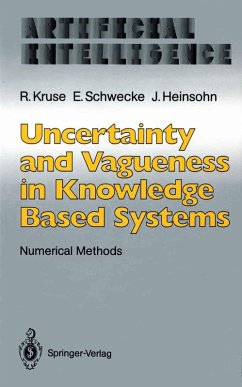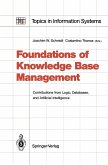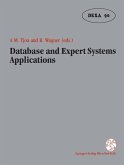Rudolf Kruse, Erhard Schwecke, Jochen Heinsohn
Uncertainty and Vagueness in Knowledge Based Systems (eBook, PDF)
Numerical Methods
72,95 €
72,95 €
inkl. MwSt.
Sofort per Download lieferbar

36 °P sammeln
72,95 €
Als Download kaufen

72,95 €
inkl. MwSt.
Sofort per Download lieferbar

36 °P sammeln
Jetzt verschenken
Alle Infos zum eBook verschenken
72,95 €
inkl. MwSt.
Sofort per Download lieferbar
Alle Infos zum eBook verschenken

36 °P sammeln
Rudolf Kruse, Erhard Schwecke, Jochen Heinsohn
Uncertainty and Vagueness in Knowledge Based Systems (eBook, PDF)
Numerical Methods
- Format: PDF
- Merkliste
- Auf die Merkliste
- Bewerten Bewerten
- Teilen
- Produkt teilen
- Produkterinnerung
- Produkterinnerung

Bitte loggen Sie sich zunächst in Ihr Kundenkonto ein oder registrieren Sie sich bei
bücher.de, um das eBook-Abo tolino select nutzen zu können.
Hier können Sie sich einloggen
Hier können Sie sich einloggen
Sie sind bereits eingeloggt. Klicken Sie auf 2. tolino select Abo, um fortzufahren.

Bitte loggen Sie sich zunächst in Ihr Kundenkonto ein oder registrieren Sie sich bei bücher.de, um das eBook-Abo tolino select nutzen zu können.
This monograph provides a formal framework for the representation and management of uncertainty and vagueness in artificial intelligence. Mathematical modeling is emphasized. The book is self-contained and suitable as an advanced textbook.
- Geräte: PC
- ohne Kopierschutz
- eBook Hilfe
- Größe: 35MB
Andere Kunden interessierten sich auch für
![Rough Sets (eBook, PDF) Rough Sets (eBook, PDF)]() Z. PawlakRough Sets (eBook, PDF)296,95 €
Z. PawlakRough Sets (eBook, PDF)296,95 €![Expert Systems in Structural Safety Assessment (eBook, PDF) Expert Systems in Structural Safety Assessment (eBook, PDF)]() Expert Systems in Structural Safety Assessment (eBook, PDF)72,95 €
Expert Systems in Structural Safety Assessment (eBook, PDF)72,95 €![Foundations of Knowledge Base Management (eBook, PDF) Foundations of Knowledge Base Management (eBook, PDF)]() Foundations of Knowledge Base Management (eBook, PDF)72,95 €
Foundations of Knowledge Base Management (eBook, PDF)72,95 €![On Knowledge Base Management Systems (eBook, PDF) On Knowledge Base Management Systems (eBook, PDF)]() On Knowledge Base Management Systems (eBook, PDF)40,95 €
On Knowledge Base Management Systems (eBook, PDF)40,95 €![Database and Expert Systems Applications (eBook, PDF) Database and Expert Systems Applications (eBook, PDF)]() Database and Expert Systems Applications (eBook, PDF)40,95 €
Database and Expert Systems Applications (eBook, PDF)40,95 €![An Introduction to Fuzzy Logic Applications in Intelligent Systems (eBook, PDF) An Introduction to Fuzzy Logic Applications in Intelligent Systems (eBook, PDF)]() An Introduction to Fuzzy Logic Applications in Intelligent Systems (eBook, PDF)160,95 €
An Introduction to Fuzzy Logic Applications in Intelligent Systems (eBook, PDF)160,95 €![Concept Formation and Knowledge Revision (eBook, PDF) Concept Formation and Knowledge Revision (eBook, PDF)]() Stefan WrobelConcept Formation and Knowledge Revision (eBook, PDF)112,95 €
Stefan WrobelConcept Formation and Knowledge Revision (eBook, PDF)112,95 €-
-
-
This monograph provides a formal framework for the representation and management of uncertainty and vagueness in artificial intelligence. Mathematical modeling is emphasized. The book is self-contained and suitable as an advanced textbook.
Dieser Download kann aus rechtlichen Gründen nur mit Rechnungsadresse in A, B, BG, CY, CZ, D, DK, EW, E, FIN, F, GR, HR, H, IRL, I, LT, L, LR, M, NL, PL, P, R, S, SLO, SK ausgeliefert werden.
Produktdetails
- Produktdetails
- Verlag: Springer Berlin Heidelberg
- Seitenzahl: 491
- Erscheinungstermin: 6. Dezember 2012
- Englisch
- ISBN-13: 9783642767029
- Artikelnr.: 53097926
- Verlag: Springer Berlin Heidelberg
- Seitenzahl: 491
- Erscheinungstermin: 6. Dezember 2012
- Englisch
- ISBN-13: 9783642767029
- Artikelnr.: 53097926
- Herstellerkennzeichnung Die Herstellerinformationen sind derzeit nicht verfügbar.
Prof. Dr. Rudolf Kruse und Dr. Jörg Gebhardt arbeiten am Institut für Betriebssysteme und Rechnerverbund der TU Braunschweig. Dr. Rainer Palm ist in der Zentralabteilung Forschung und Entwicklung der Siemens AG München tätig.
1. General Considerations of Uncertainty and Vagueness.- 1.1 Artificial Intelligence.- 1.2 Modeling Ignorance.- 1.3 The Scope of the Book.- 2. Introduction.- 2.1 Basic Notations.- 2.2 A Simple Example.- 2.3 Vagueness and Uncertainty.- 3. Vague Data.- 3.1 Basic Concepts.- 3.2 On the Origin of Vague Data.- 3.3 Uncertainty Handling by Means of Layered Contexts.- 3.4 The General Case.- 3.5 Concluding Remarks.- 4. Probability Theory.- 4.1 Basic Concepts.- 4.2 Probabilities on Different Sample Spaces.- 4.3 Bayesian Inference.- 4.4 Classes of Probabilities.- 4.5 Decision Making Aspects.- 4.6 Aggregating Probability Distributions.- 4.7 Concluding Remarks.- 5. Random Sets.- 5.1 Random Variables.- 5.2 The Notion of a Random Set.- 5.3 Decision Making in the Context of Vague Data.- 5.4 The Notion of an Information Source.- 5.5 Concluding Remarks.- 6. Mass Distributions.- 6.1 Basic Concepts.- 6.2 Different Frames of Discernment.- 6.3 Measures for Possibility/Necessity.- 6.4 Generalized Mass Distributions.- 6.5 Decision Making with Mass Distributions.- 6.6 Knowledge Representation with Mass Distributions.- 6.7 Simplifying Assumptions.- 6.8 Concluding Remarks.- 7. On Graphical Representations.- 7.1 Graphs and Trees.- 7.2 Hypergraphs and Hypertrees.- 7.3 Analysis of Simple Hypertrees.- 7.4 Dependency Networks.- 7.5 Triangulated Graphs.- 7.6 Directed Acyclic Graphs.- 7.7 Concluding Remarks.- 8. Modeling Aspects.- 8.1 Rule Based Approaches.- 8.2 Model Based Representations.- 8.3 Dependency Network Based Systems.- 9. Heuristic Models.- 9.1 MYCIN - The Certainty Factor Approach.- 9.2 RUM - Triangular Norms and Conorms.- 9.3 INFERNO - A Bounds Propagation Architecture.- 9.4 Other Heuristic Models.- 10. Fuzzy Set Based Models.- 10.1 Fuzzy Sets.- 10.2 Possibility Distributions.- 10.3Approximate Reasoning.- 10.4 Reasoning with Fuzzy Truth Value.- 10.5 Conclusions.- 11. Reasoning with L-Sets.- 11.1 Knowledge Representation with L-Sets.- 11.2 On the Interpretation of Vague Rules.- 11.3 L-Sets on Product Spaces.- 11.4 Local Computation of Marginal ¿-Sets.- 11.5 The Propagation Algorithm.- 11.6 Aspects of Implementation.- 12. Probability Based Models.- 12.1 The Interpretation of Rules.- 12.2 The Straightforward Use of Probabilities.- 12.3 PROSPECTOR - Inference Networks.- 12.4 Decomposable Graphical Models.- 12.5 Propagation Based on Dependency Networks.- 12.6 Concluding Remarks.- 13. Models Based on the Dempster-Shafer Theory of Evidence.- 13.1 The Mathematical Theory of Evidence.- 13.2 Knowledge Representation Aspects.- 13.3 The Straightforward Use of Belief Functions.- 13.4 Belief Functions in Hierarchical Hypothesis Spaces.- 13.5 MacEvidence - Belief Propagation in Markov Trees.- 13.6 Conclusions.- 14. Reasoning with Mass Distributions.- 14.1 Matrix Notation for Specializations.- 14.2 Specializations in Product Spaces.- 14.3 Knowledge Representation with Mass Distributions.- 14.4 Local Computations with Mass Distributions.- 14.5 The Propagation Algorithm.- 14.6 Aspects of Implementation.- 15. Related Research.- 15.1 Nonstandard Logics.- 15.2 Integrating Uncertainty Calculi and Logics.- 15.3 Symbolic Methods.- 15.4 Conclusions.- References.
1. General Considerations of Uncertainty and Vagueness.- 1.1 Artificial Intelligence.- 1.2 Modeling Ignorance.- 1.3 The Scope of the Book.- 2. Introduction.- 2.1 Basic Notations.- 2.2 A Simple Example.- 2.3 Vagueness and Uncertainty.- 3. Vague Data.- 3.1 Basic Concepts.- 3.2 On the Origin of Vague Data.- 3.3 Uncertainty Handling by Means of Layered Contexts.- 3.4 The General Case.- 3.5 Concluding Remarks.- 4. Probability Theory.- 4.1 Basic Concepts.- 4.2 Probabilities on Different Sample Spaces.- 4.3 Bayesian Inference.- 4.4 Classes of Probabilities.- 4.5 Decision Making Aspects.- 4.6 Aggregating Probability Distributions.- 4.7 Concluding Remarks.- 5. Random Sets.- 5.1 Random Variables.- 5.2 The Notion of a Random Set.- 5.3 Decision Making in the Context of Vague Data.- 5.4 The Notion of an Information Source.- 5.5 Concluding Remarks.- 6. Mass Distributions.- 6.1 Basic Concepts.- 6.2 Different Frames of Discernment.- 6.3 Measures for Possibility/Necessity.- 6.4 Generalized Mass Distributions.- 6.5 Decision Making with Mass Distributions.- 6.6 Knowledge Representation with Mass Distributions.- 6.7 Simplifying Assumptions.- 6.8 Concluding Remarks.- 7. On Graphical Representations.- 7.1 Graphs and Trees.- 7.2 Hypergraphs and Hypertrees.- 7.3 Analysis of Simple Hypertrees.- 7.4 Dependency Networks.- 7.5 Triangulated Graphs.- 7.6 Directed Acyclic Graphs.- 7.7 Concluding Remarks.- 8. Modeling Aspects.- 8.1 Rule Based Approaches.- 8.2 Model Based Representations.- 8.3 Dependency Network Based Systems.- 9. Heuristic Models.- 9.1 MYCIN - The Certainty Factor Approach.- 9.2 RUM - Triangular Norms and Conorms.- 9.3 INFERNO - A Bounds Propagation Architecture.- 9.4 Other Heuristic Models.- 10. Fuzzy Set Based Models.- 10.1 Fuzzy Sets.- 10.2 Possibility Distributions.- 10.3Approximate Reasoning.- 10.4 Reasoning with Fuzzy Truth Value.- 10.5 Conclusions.- 11. Reasoning with L-Sets.- 11.1 Knowledge Representation with L-Sets.- 11.2 On the Interpretation of Vague Rules.- 11.3 L-Sets on Product Spaces.- 11.4 Local Computation of Marginal ¿-Sets.- 11.5 The Propagation Algorithm.- 11.6 Aspects of Implementation.- 12. Probability Based Models.- 12.1 The Interpretation of Rules.- 12.2 The Straightforward Use of Probabilities.- 12.3 PROSPECTOR - Inference Networks.- 12.4 Decomposable Graphical Models.- 12.5 Propagation Based on Dependency Networks.- 12.6 Concluding Remarks.- 13. Models Based on the Dempster-Shafer Theory of Evidence.- 13.1 The Mathematical Theory of Evidence.- 13.2 Knowledge Representation Aspects.- 13.3 The Straightforward Use of Belief Functions.- 13.4 Belief Functions in Hierarchical Hypothesis Spaces.- 13.5 MacEvidence - Belief Propagation in Markov Trees.- 13.6 Conclusions.- 14. Reasoning with Mass Distributions.- 14.1 Matrix Notation for Specializations.- 14.2 Specializations in Product Spaces.- 14.3 Knowledge Representation with Mass Distributions.- 14.4 Local Computations with Mass Distributions.- 14.5 The Propagation Algorithm.- 14.6 Aspects of Implementation.- 15. Related Research.- 15.1 Nonstandard Logics.- 15.2 Integrating Uncertainty Calculi and Logics.- 15.3 Symbolic Methods.- 15.4 Conclusions.- References.







